Marigolds: characteristics, varieties, nuances of cultivation

Surely everyone saw orange flowers that adorn the flower beds and bloom until autumn. Tall, with bright inflorescences of rich orange color and with a warm, slightly harsh aroma, marigolds delight gardeners throughout the summer months.

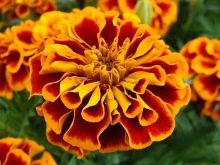
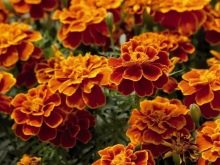
Description
Naturally, the description "grew up in my grandmother's flowerbed" can tell little about these plants. Marigolds are divided into two categories - perennial and annual (they bloom for only one season) and belong to the Asteraceae family (Compositae). These flowers look like a small shrub, as they tend to grow very violently.
In addition to the category dividing marigolds according to the life span of a flower, there is another one - this is a way of growth. So, the most often grown are considered erect (African), rejected (French, another less common name - "Patula" or "Patula") and thin-leaved (Mexican). The height of the flower also depends on this. The height of the rejected ones varies from 30 to 60 centimeters (depending on the care and climatic characteristics). The erect subspecies, as a rule, are higher - its size can reach almost 90 centimeters.
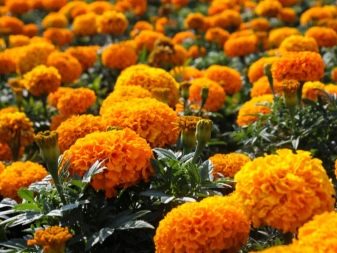
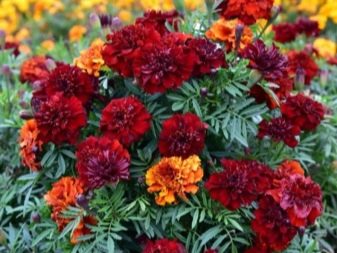
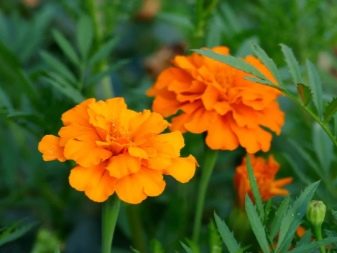
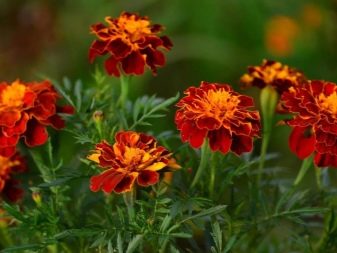
Another name that these flowers received (it is also scientific) is tagetes (from Latin tagetes). They received this name in honor of the Etruscan demigod Tages, who was the grandson of the god Jupiter and gave people the gift of the ability to predict, predict the will of the gods and guess. After all that Tages was able to be learned by people, he died, or, according to legend, turned to stone. Such variants of names as black shaves and marigold are also common.
Marigolds grow almost on their own, requiring only minimal effort to care, but they do it incredibly beautifully... One of the features of this plant is an unobtrusive but strong aroma, which flowers begin to exude a few days before flowering, since it is not the buds that smell, but the leaves of marigolds.
Their flowering time is very long - practically from the first summer days (from the beginning of June or even from the end of May in the presence of favorable climatic conditions) until the first frost.
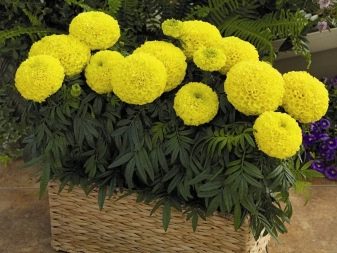

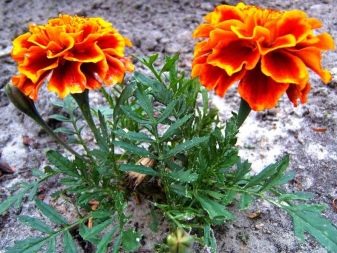
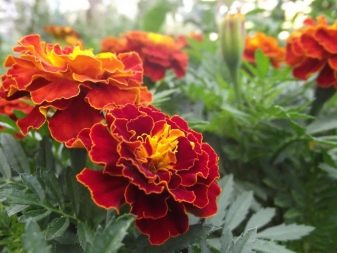
Types and varieties
Breeders have bred about 40 different varieties of this plant. However, progress does not stand still and it is quite possible that soon as many different subspecies may appear. Let's take the most beautiful varieties as an example.
The category of low-growing bush marigolds includes low species that are ideal for decorating free areas of a garden or balcony.
Supra is a small species of bright colors in all shades of yellow - from rich to lemon... The flowering time, like that of the entire marigold family, is from the first days of June to the first cold autumn. They have large inflorescences, similar fluffy caps, with a diameter of about 10 centimeters. They can grow in height up to 20 (rarely up to 30) centimeters. They are very hardy, tolerate small summer frosts better than sultry heat.

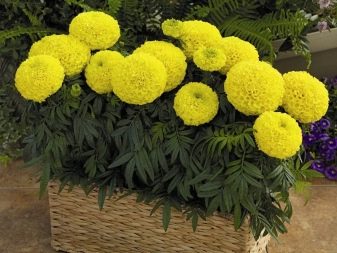
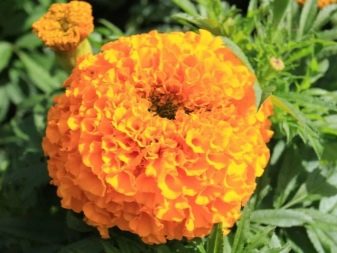
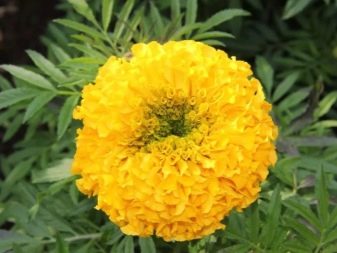
A species that, on the contrary, tolerates hot weather well with little rainfall - Merigold Moonlight... It is also hardy and does not require constant care and monitoring. They reach a height of about 30 centimeters, sometimes taller. The diameter of a fully blossoming bud is about 8 centimeters. They are very fond of light, but they will not wither in partial shade.
Their scent is believed to help balance the stress and tidy up the nervous system.
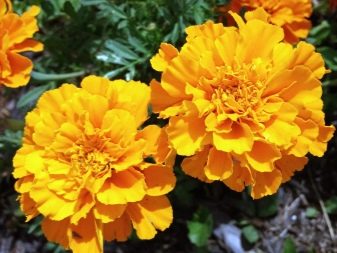
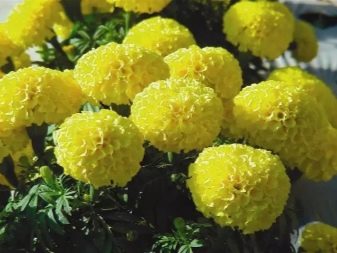
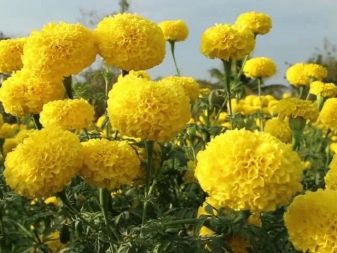

The tallest species among low-growing shrubs - The Orange Prince. Its sturdy stem can grow up to 60-70 centimeters. It is also a champion in "fluffiness" - the diameter of its inflorescence reaches 12 centimeters and has a very rich orange color (similar to that of an orange, but slightly darker).
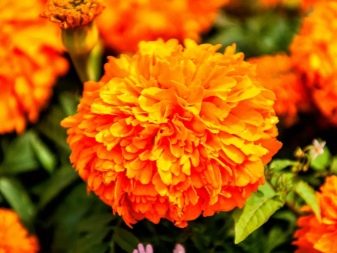
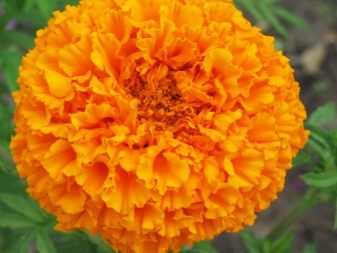
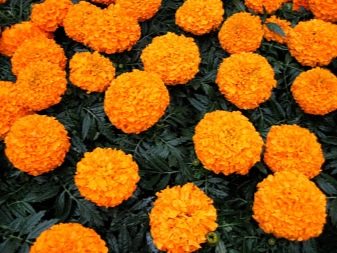

A very delicate variety of low-growing marigolds - Vanilla. Like everyone else, it does not require attention and great effort for cultivation, it tolerates dry weather well, it is very light-loving, however (and this is the only condition for growing) it hardly tolerates cold and even the slightest frost. Average in height - reaches about 40 centimeters, inflorescences about 10 centimeters in diameter. It resembles vanilla ice cream or vanilla flowers in color.
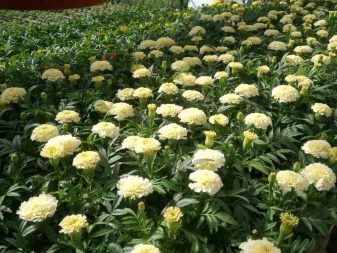
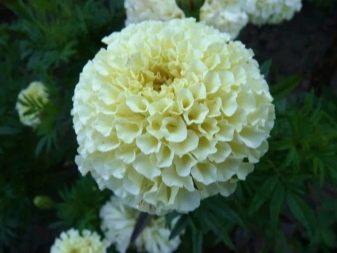
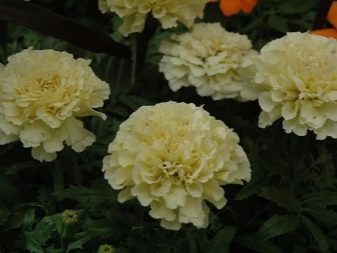
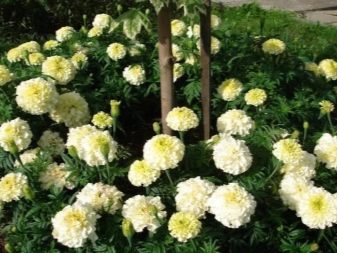
The varieties of low-growing shrub marigolds are not limited to the above, so if you wish, you can choose a small plant according to your tastes.
One of the most unusual and beautiful varieties - Strawberry Blond. They belong to the category of rejected (French) marigolds. Their peculiarity lies in the fact that small inflorescences of different colors bloom on one bush.
It is believed that this type of annual flower was discovered not so long ago. Some people believe that the color of the buds changes in accordance with the air temperature in the room where the plant pot is located. That is, first inflorescences of darker shades open - from reddish-brown to dark yellow, and later the flowers seem to "fade" and bloom in cool pink and lemon tones. Low, in height can reach a maximum of 30 centimeters. The diameter of the inflorescence is about 5-6 centimeters.
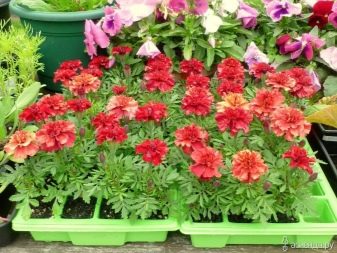
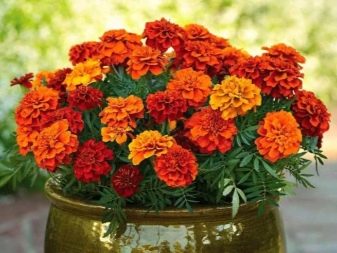
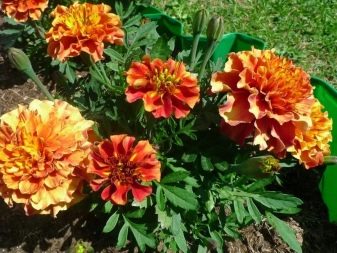
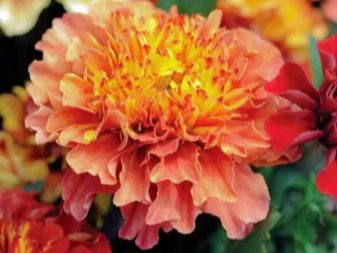
The next variety is also characterized by the presence of several shades in the inflorescence. More precisely, two - red and yellow. This is the grade Mercedes, which belongs to the rejected subspecies. It grows to a maximum of 30 centimeters, blooms in small flowers with a diameter of about 4-5 centimeters. In the bud, it has two colors - a rich yellow central part (core) and a dark red or just red circle from the center to the edge of the petals.
It is worth remembering that this variety does not tolerate low temperatures and prefers heat, and also loves light very much.
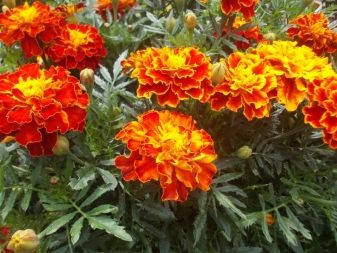
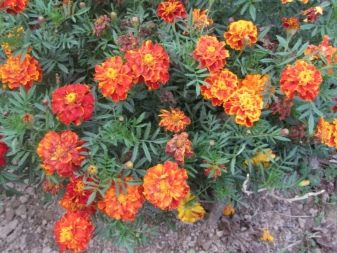
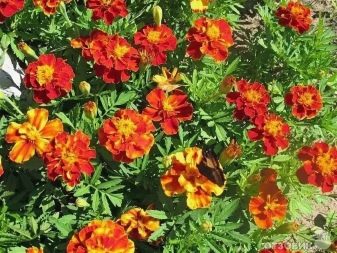

Another two-color variety - Dune Gold. They belong to the upright (African) varieties. It grows in a small neat bush, which can reach about 30 centimeters in height. The buds are large, up to 10 centimeters in diameter, have two shades in their colors - thick yellow takes up most of the petals, but deep red illumination is visible in the depth. They are very fond of sunlight and warmth, but do not respond well to cold weather.
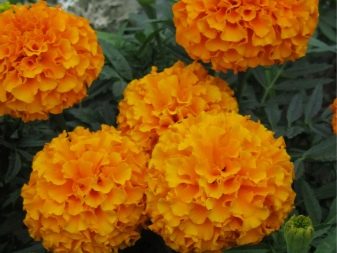
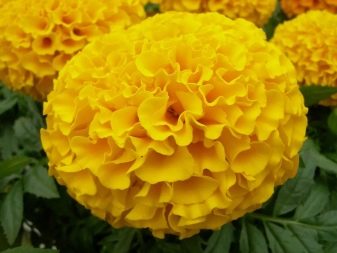


How to grow properly?
Despite the fact that growing and caring for marigolds does not require special skills, you still need to know and follow the simplest rules for planting these flowers, and then they will delight you throughout the summer. How to plant marigolds correctly, in diapers or without, whether it is necessary to germinate seeds, and if necessary, in what time frame is the most necessary information, but its study will not take much time.
Landing
First you need to decide what kind of plant you need. Agree, it is not very pleasant when a bush 60 centimeters high grows on the balcony or windowsill and blocks all the sunlight.
Once you have decided on a variety, you can decide exactly how you want to grow flowers. If it is already the middle of summer (since marigolds are usually sown in May), then you can purchase an already sprouted small bush and transplant it to your flower bed - the plant is most likely to take root in a new place.
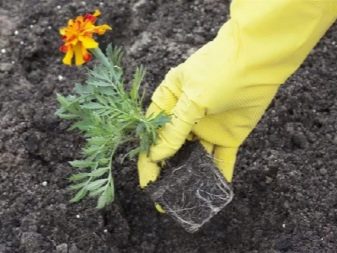
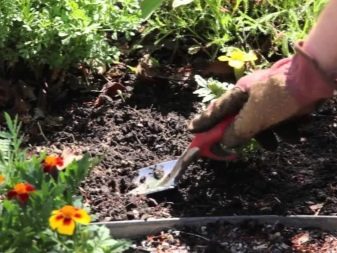
You can also purchase seeds from a flower shop and plant them in the soil.It happens like this: a small groove is dug, about 5 centimeters deep, filled with water. The water should be slightly absorbed into the soil, after which the seeds are sown. We fill the furrow with seeds with soil and wait for the first shoots. This usually happens a few weeks after disembarkation (two or three weeks). It happens that the seeds germinate too close to each other. In this case, you need to wait until the plant has a stronger root system (about a week or two) and carefully plant the flowers as convenient.
If you are afraid that the seeds will not sprout (although this almost never happens), then you can prepare them in advance for sowing. To do this, put the seeds in a separate shallow container (any flat saucer is very good for this purpose), cover the top with a cloth dipped in warm water, wrap in a small transparent bag to create the effect of a greenhouse and put in a warm or very sunny place.
After a few days, the seeds should give the first green shoots, after which they must be transferred to the soil.
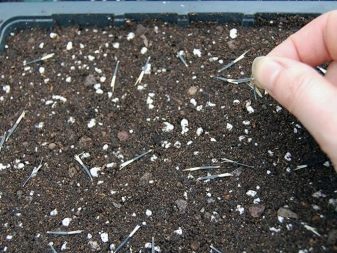
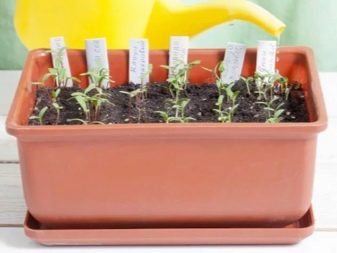
In the spring, you can plant seeds for seedlings yourself. You can do this even from the beginning of March, because what time (before the onset of May, for sure) the seedlings will be in your home. In order for all flowers to bloom at the same time, you need to know the approximate time during which the plant will give its first shoots, will begin to stretch up and take root and continue its growth after transplantation. So, in mid-March, it is worth sowing upright marigolds. But thin-leaved and undersized plants should be planted in about a month, that is, from the beginning of April. If everything was done correctly, then all three varieties will begin flowering at about the same time - in June.
One of the main conditions for the correct cultivation of seedlings is the availability of soil suitable for the plant. It is necessary to prepare a mixture of peat, humus and turf in a 1: 1 ratio. Then add sand to half of any of the components (that is, 0.5). As a result, we get the following composition: turf (1), peat (1), humus (1), sand (0.5).
We select a suitable container (preferably in the form of a wide square) and disinfect the resulting soil mixture with a solution of dark pink potassium permanganate.
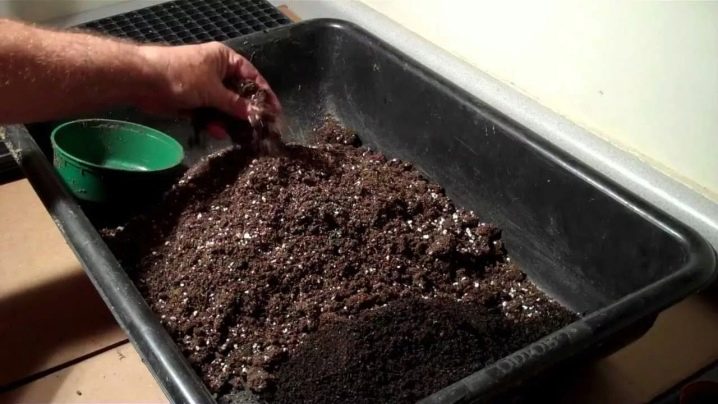
At the bottom of the improvised "pot" it is necessary to lay a drainage system of sand, gravel and expanded clay, at least three centimeters high. This must be done so that moisture does not stagnate in the soil and does not provoke root rotting from dampness.
If desired, you can fertilize the soil before planting seeds (just do not use fresh manure for this purpose), but this is not necessary.
Once the soil has been prepared, the seeds can be planted. To do this, make small grooves with your finger (the distance between them should be at least two centimeters) and pour the seeds inside, then dig in with a small layer of earth. Watering during this period must be done very carefully and necessarily from a close distance, so that the pressure of water does not erode the soil and wash the seeds to the surface. Then we transfer the container to a warm place where the temperature is maintained at least 20 degrees.
The soil should always be moist, therefore it is necessary to ensure constant watering. When the first shoots appear (this usually happens after a week or two), then the container must be rearranged in a place where there is enough sunlight, and the temperature must be maintained no higher than 18, but not less than 15 degrees.
Picking
First you need to find out what it is. So, picking is cutting off about one third of the main root shaft during an intermediate transplant. An intermediate transplant is the transplanting of seedlings from a container to another location (for example, in another container, larger) before transplanting the plant into open ground. It should be noted that picking is not always accompanied by cutting the taproot.
In marigolds, a pick is considered possible when at least three first leaves have appeared on the seedlings. This indicates that the root is functioning normally and provides the plant with all the necessary nutrients. It is much easier to dive marigolds than some other plants. They do not require pruning of the main root. It is only necessary to plant all young additional shoots (shoots) in different places, and leave the main rhizome in place.
It is known that after transplanting, these flowers begin to stretch upward very quickly, since the main root of each plant receives more soil, and therefore more nutrients that were previously used to feed small shoots.
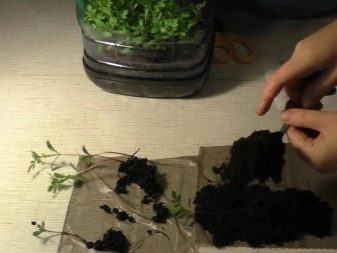
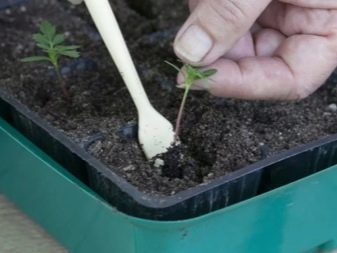
Outdoor care
After picking, you need to wait some time, which is determined by the state of the flower. If, after a pick, the plant looks painful, then you should not disturb it, in these cases it is necessary to wait about a month. If everything went well and the flower quickly stretches upward, then after two weeks it can already be moved to open ground.
The best period for planting marigolds in nature comes when the air temperature at night becomes positive and in no way less than 6 degrees... They can be planted on almost any land, but the best results are achieved on loamy soil.
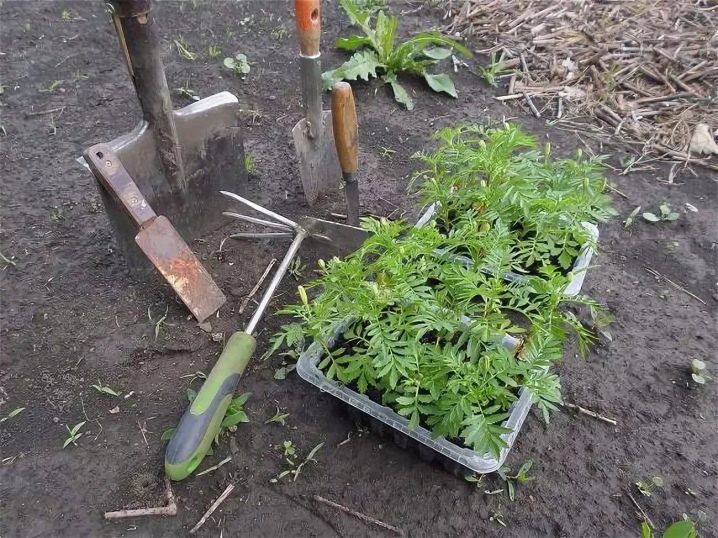
Despite the fact that marigolds are unpretentious, or maybe that is why, they grow very wide in width, and even the smallest variety will look like a small shrub, therefore the distance between them must be at least 15 centimeters. If you decide to transplant large adult bushes, then a distance of up to 40 centimeters is required.
Marigolds do not require abundant watering, a moderate amount of moisture is enough for them. There are only two basic rules to remember: in very hot weather, water the flowers in the evening (as wet soil can become very hot and burn the roots) and prevent moisture accumulation and the formation of dampness (this can lead to rotting of the roots).
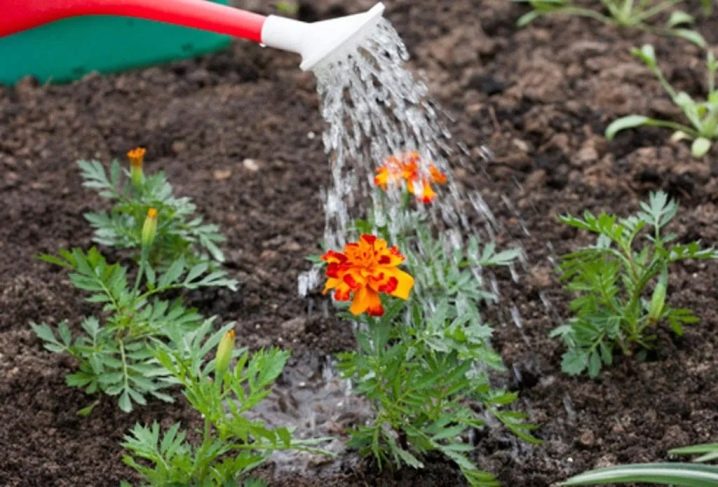
Fertilizing marigolds is optional, but if you wish, you can do it three times during the entire growth cycle: after picking (during active growth of seedlings), during the appearance of the first buds and during their opening. For this, only organic fertilizers should be used.
In addition, it is necessary to loosen the soil around the roots, which promotes more oxygen and has a positive effect on the growth of flowers. It is also necessary to get rid of weeds and already faded inflorescences in time.

Disease and pest control
One of the most obvious symptoms indicating that something is wrong with the plant is the lack of flowering.
The most commonplace that can lead to the absence of buds is improper care. Very often, the cause can be an overdose with flower feeding or the amount of moisture. Or, conversely, too dry soil, dry air and lack of sunlight.
First of all, check how you care for the plant, and if the reason lies in this, then after its elimination, the marigolds will bloom and will delight the eye until the first frost.
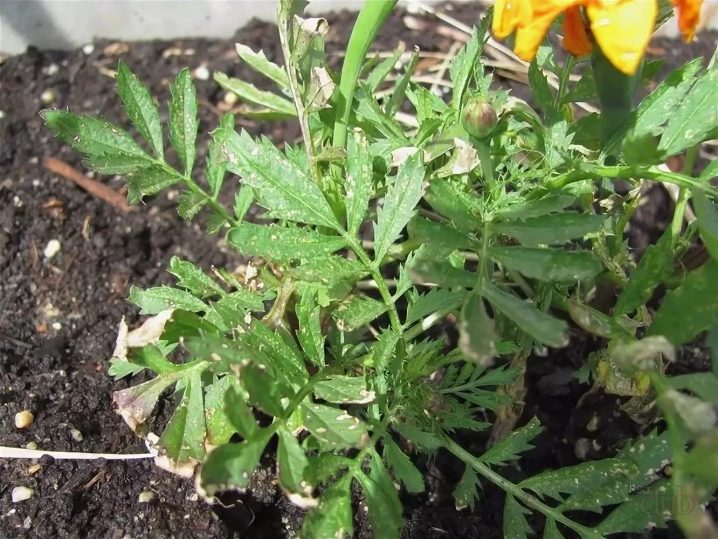
The next problem is the disease caused by the parasite. A whitish coating on the leaves indicates the presence of spider mite. This pest does not like moisture, so it is necessary to spray the leaves with water from a spray bottle several times a day. But before that, diseased individuals must be removed from healthy ones and returned to their place only after "recovery". This can be done by transplanting to another place.
And so that the spider mite escapes and does not return, you can alternate spraying with water with spraying with a solution of tincture of tobacco and laundry soap, mixed in approximately equal proportions.
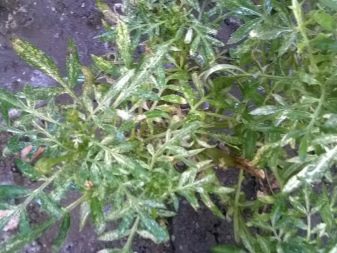
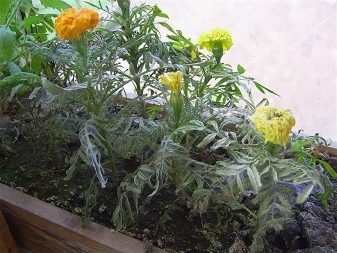
If you notice white spots on the leaves, and the leaves themselves begin to roll up at the edges and sometimes become covered with drops that look like dew, then the plant is affected powdery mildew (she is linen among the people). This fungal disease is considered one of the most dangerous, as it spreads very quickly throughout the plant.... This disease steals away nutrients needed by the plant and interferes with the healthy photosynthesis process.
First, you need to get rid of all damaged leaves. Do not be afraid that you will remove too much - the fewer diseased parts remain, the higher the chances of recovery for the entire plant. After that, it is necessary to spray all parts of the plant on the surface with a sulfur-based fungicide. It is necessary to do this so that the plant looks wet from all sides, as if after a heavy downpour. Some part of the solution will drain and process the soil, but it is better to play it safe and process the soil of the entire flower bed.
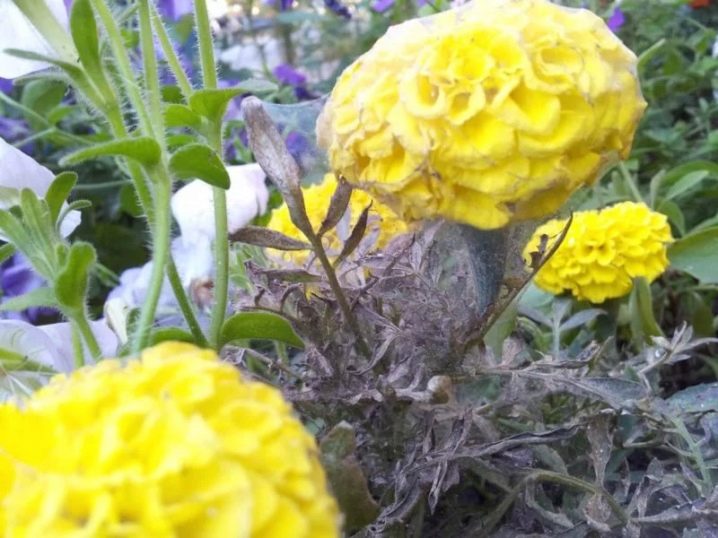
It happens that darkened spots of rot appear at the bottom of the stem. This means that the plant has hit blackleg. It is necessary to immediately get rid of all diseased plants, no matter how small the lesions seem. Healthy ones need to be transplanted into another soil as soon as possible, previously disinfected with a dark pink solution of potassium permanganate or a fungicide (the latter is preferable).
If there are no external signs of the disease, but the plant still withers and withers, then this root rot... In this case, the problem again lies in improper care - it is necessary to follow the rules for watering, fertilizing (not with manure!) And loosening the soil near the plant, but this is only prevention.
There is no cure for root rot, all diseased plants are destroyed. It is not recommended to use contaminated soil for the next growing season.
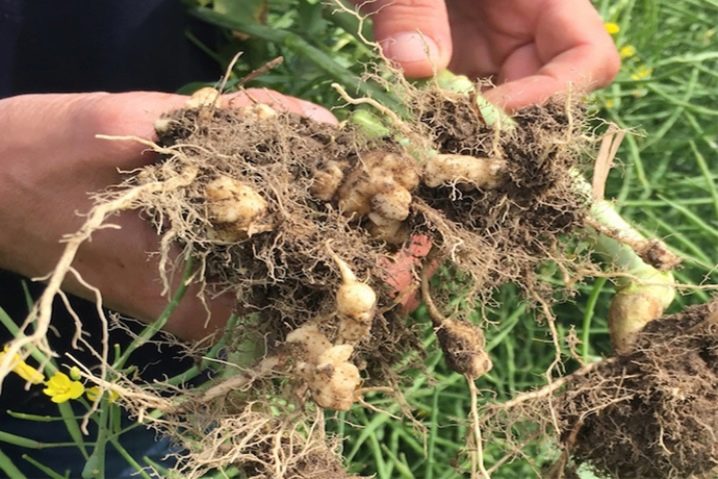
All plants affected by viral diseases are also destroyed. This will be pointed out black spots and rust-colored patterns on the leaves.
If the plant looks sick, then do not rush to diagnose rotting roots. First, you need to carefully examine the trunk of the plant, and if you see suspiciously moving green balls, this is aphid. In small quantities, it is not dangerous, but large colonies interfere with the normal development of the plant, as they devour nutrients, and in addition, they can provoke a fungal infection. To get rid of aphids, you must use any insecticide - Aktara, Fufanon or Iskra. Each of them lasts about 3 weeks.



They can also attack the plant slugs. You can understand this by the eaten holes in the leaves or damaged stems. Homemade traps made from any materials at hand will help with slugs. For example, under any board, slugs can hide from the light, which means that knowing their location, you can destroy pests. There are also special preparations for the same purposes, for example, "Storm", which, however, requires protection of the human upper respiratory tract... It is much safer to spray the plant tincture of garlic.
The hardest pests to detect are thrips. They hide in the buds of a plant, suck out juices, nutrients and spread various diseases. They also reproduce very quickly. Signs of damage by thrips: small holes on the leaves, a change in the shape of the bud, the loss of petals from the inflorescence. Thrips should be dealt with with systemic insecticides. It is necessary to make a solution from special means: Intavir, Aktellik and Karate.
Plants need to be sprayed once a day in the absence of wind.
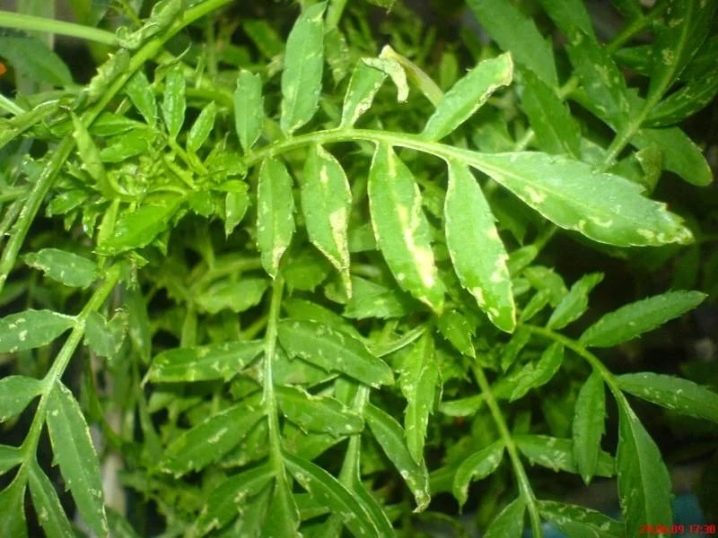
Reproduction
Marigolds reproduce by seeds. To do this, at the end of the life cycle, it is necessary to collect the buds, dry them, and then pour the seeds into a separate container. They can be sown next year. However, remember that most marigolds are hybrids, so the seeds are likely to inherit the qualities of either the father plant or only the mother plant.

Examples in landscape design
Marigolds are ornamental plants that can decorate almost any room. You just need to correlate the characteristics of the growth and development of their breeds with where you want to grow them.
Any varieties are suitable for growing in the garden - from the smallest to the tallest, so feel free to plan a garden design with any plants - a huge species of marigold will fit into absolutely any space.
Accommodation near the house and in a free area in the country is one of the most successful - you can create an entire blooming jungle, or you can create a small neat terrace.


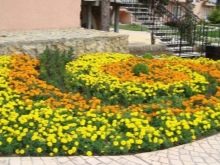
For the cultivation and care of marigolds, see below.







































































































The comment was sent successfully.